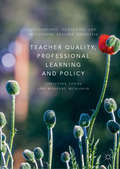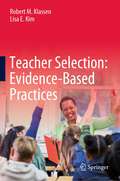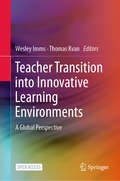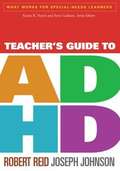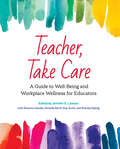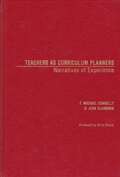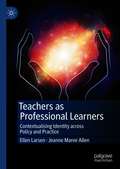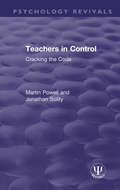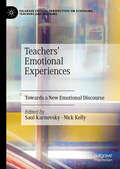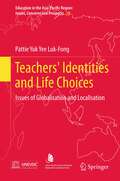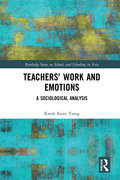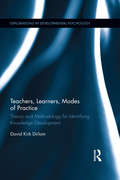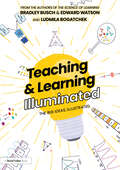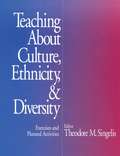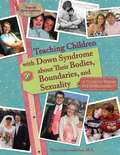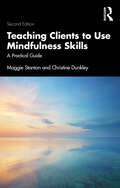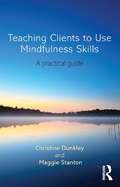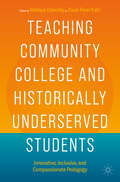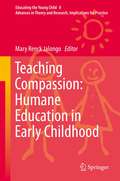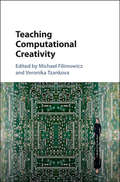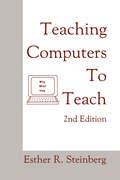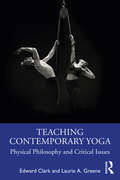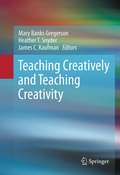- Table View
- List View
Teacher Quality, Professional Learning and Policy: Recognising, Rewarding and Developing Teacher Expertise
by Christine Forde Margery McMahonThis book examines the significance of teacher expertise in the drive to improve quality and effectiveness. Scrutinising both key conceptual issues and current policy developments and approaches, the authors analyse educational systems from around the world and question how different cultural contexts and systems can implement measures to improve teacher effectiveness. The book analyses factors such as policy change and teacher evaluation as well as the regulation of the teaching profession to determine how these aspects can influence the expertise of individual teachers. As numerous policy interventions have tried to define and enhance teacher quality to raise pupil achievement, this book calls for an interrogation of this stance and signals a need to consider an alternative approach. This book will appeal to students and scholars of teacher effectiveness and professional learning, as well as researchers and policymakers.
Teacher Selection: Evidence-Based Practices
by Robert M. Klassen Lisa E. KimMarketing text: This book combines theory and research from educational and organizational psychology to provide guidance on improving the teacher selection process and, subsequently, educational outcomes for all students. The book identifies the characteristics of effective teachers, analyzes research on selection practices, and examines new approaches to teacher selection, recruitment, and development. The central premise of the book is that improving the effectiveness of teachers – and, thus, students’ educational outcomes – can be achieved by making the recruitment and selection process more effective and more efficient. Accordingly, the book describes how to identify and select individuals for the teaching profession who display both strong cognitive attributes (e.g., subject knowledge) and essential non-cognitive attributes such as resilience, commitment to the profession, and motivation for teaching. Key topics Teacher selection practices from the viewpoint of organizational and educational psychology Teacher effectiveness and the role of individual attributes Situational judgment tests (SJTs) and multiple mini-interviews (MMIs) for teacher selection Implementation of teacher selection programs Teacher recruitment and development Given its scope, the book represents an essential reference guide for scholars, educational leaders and policymakers, and graduate students in educational leadership programs, as well as professionals in child and school psychology, educational psychology, teaching and teacher education.
Teacher Transition into Innovative Learning Environments: A Global Perspective
by Thomas Kvan Wesley ImmsThis open access book focuses on how the design and use of innovative learning environments can evolve as teaching practices and education policies change. It addresses how these new environments are used, how teachers are adapting their practices, the challenges that these changes pose, and the effective evaluation of these changes. The book reports on emerging research in learning environments, with a particular emphasis on how teachers are transitioning from traditional classrooms to innovative learning environments. It offers a significant evidence-based global assessment of current research in this field by designers, architects, educators and policy makers. It presents twenty-five cutting-edge projects from researchers in fifteen countries. Thanks to the book’s comprehensive international perspective, which combines theory and practice in a single publication, readers will gain a wealth of new insights.
Teacher's Guide to ADHD
by Joseph Johnson Robert ReidMeeting a key need for teachers, this book provides practical, data-based tools for helping students with attention-deficit/hyperactivity disorder (ADHD) succeed in the classroom. The authors combine instructional expertise with extensive knowledge about the nature and treatment of ADHD. Coverage includes ways to support students and teach them needed strategies in core areas: academic skills, behavior, self-regulation, and social skills. Step-by-step instructions and concrete examples help teachers implement effective interventions and accommodations. The book also offers crucial guidance for teaming with other school professionals and with parents.
Teacher, Take Care: A Guide to Well-Being and Workplace Wellness for Educators
by Megan Hunter Keith Macpherson Cher Brasok Monika Cichosz Rosney Laura Doney Dana Fulwiler Volk Jackie Gagné Kelsey McDonald Lisa Dumas Neufeld Sandra Pacheco Melo Richelle North Scott Joyce SunadaTeaching can be a highly satisfying profession, but it can also be overwhelming. Stress management. Self-care. Mental well-being. Mindfulness. These words have become all too familiar, but what do they actually mean for you? And how can they help without adding to your to-do list?All teachers have different experiences and different needs. Through stories by diverse educators, this professional resource invites you to try different wellness strategies, explore varying perspectives, and consider new ideas of what it means to &“be well.&”Grounded in servant leadership and a holistic model, each chapter connects to Indigenous perspectives of wellness through remarks from Elder Stanley Kipling and Knowledge Keeper Richelle North Star Scott.
Teacher, Take Care: A Guide to Well-Being and Workplace Wellness for Educators
by Megan Hunter Keith Macpherson Cher Brasok Monika Cichosz Rosney Laura Doney Dana Fulwiler Volk Jackie Gagné Kelsey McDonald Lisa Dumas Neufeld Sandra Pacheco Melo Richelle North Scott Joyce SunadaTeaching can be a highly satisfying profession, but it can also be overwhelming. Stress management. Self-care. Mental well-being. Mindfulness. These words have become all too familiar, but what do they actually mean for you? And how can they help without adding to your to-do list?All teachers have different experiences and different needs. Through stories by diverse educators, this professional resource invites you to try different wellness strategies, explore varying perspectives, and consider new ideas of what it means to &“be well.&”Grounded in servant leadership and a holistic model, each chapter connects to Indigenous perspectives of wellness through remarks from Elder Stanley Kipling and Knowledge Keeper Richelle North Star Scott.
Teachers As Curriculm Planners: Narratives Of Experience
by F. Michael Connelly Jean D. ClandininThis is a book for teachers. It is a book for preservice, novice, and experienced teachers. It is a book that celebrates the experience of each and every one of us who teaches. We show, often in the words of teachers with whom we have worked, how reflection on our narratives of experience helps us make meaning of our lives as teachers.
Teachers as Professional Learners: Contextualising Identity across Policy and Practice
by Ellen Larsen Jeanne Maree AllenDrawing upon data from an Australian study, this book gives voice to beginning teachers navigating their way through their first year of teaching and discovering what it means to be professional learners. The chapters within provide rich insights into the ways in which beginning teachers make sense of the new and challenging experiences they face during the first year of teaching, and how these influence the development of their learner identities at this formative time of their careers. Professional learning, in response to teacher standards and associated accountability measures, often fails to acknowledge the importance of internal motivation and attitude to beginning teachers’ sense of a professional learner identity. This book offers policy makers, teacher educators, school leaders, mentors and teachers a way of thinking about how beginning teachers can be supported to grow professionally and construct their identities as professional learners.
Teachers in Control: Cracking the Code (Psychology Revivals)
by Martin Powell Jonathan SolityIn an increasingly centralized education system, how can teachers recover the freedom to make their own decisions? Originally published in 1990, the teaching profession had seldom been under greater pressure. Teachers in Control aimed to help teachers to understand the forces that shaped their personal and professional development and their relationships with children at the time. It identifies the pressures that teachers faced, from both the school and the educational system as a whole, and then examines the internal, psychological influences that lead people into teaching and direct their future careers. The authors argue that an understanding of these influences can give teachers more control of decisions that affect their practice in the classroom and will still be very relevant today.
Teachers' Emotional Experiences: Towards a New Emotional Discourse (Palgrave Critical Perspectives on Schooling, Teachers and Teaching)
by Nick Kelly Saul KarnovskyThis edited book seeks to address the impoverished culture of emotional discourse in the teaching profession and teacher education. Teachers across the world live out emotional experiences in their professional lives (in the classroom, in the staffroom, online) yet the language available for talking about these experiences is fragmented and often inadequate. The book draws on a broad range of theories including psychoanalytic, critical, feminist, sociological and poststructural to expand a rich conceptual language for talking about teachers’ emotional experiences, originating from the authentic voices of teachers themselves. The book is unified by the inclusion of unpublished, first-hand accounts of teachers, drawn from the editors’ own empirical research interviewing a diverse group of teachers over many years. Each chapter includes a direct voice of a teacher telling their own story, in their own words, about an experience they found to be emotionally significant—the challenging, the sublime, and the downright distressing. Scholarly responses to each of these interviews weave a novel imagining for teachers’ emotional discourse within schools. The chapters discuss the complex contexts of teachers’ professional-emotional lives, such as neoliberal school systems, fraught relationships with leaders, contractualisation, toxic positivity, intractable behaviour problems and datafication. The book will be useful for education researchers, scholars of teachers and teacher education as well as teachers themselves, their families, and those who wish to work with and understand the complex dynamics of the teaching profession.
Teachers' Identities and Life Choices
by Pattie Luk-FongThis book discusses issues related to teachers' identities and life choices when globalisation and localisation are enmeshed. It examines how competing cultural traditions and contexts acted as resources or/and constraints in framing teachers' identities and their negotiations in the family and the work domains according to their gender positioning, their roles in the family such as husband, wife, father, mother, brother, sister, son and daughter and roles in the school such as principal, senior teacher or regular teacher. Contrary to an essentialist approach to identity and culture, teachers' stories show that their identities and life choices were hardly free choices; but were often part and parcel of the culture and contexts in which they were embedded. Teachers' identities are found to be fluid, complex, hybrid and multifaceted. Using Hong Kong as a case study, this book provides not only traces of the continuity and changes of Confucian self and cardinal relationships but also a glimpse of how educational reform as neo-capitalist discourses in the workplace interacts with Confucian cultural traditions creating new hybrid practices (problems or possibilities or both) in the school and in the daily lives of teachers.
Teachers' Work and Emotions: A Sociological Analysis (Routledge Series on Schools and Schooling in Asia)
by Kwok Kuen TsangBeing a teacher is often thought of as an emotionally fulfilling job, with many positive experiences in watching students grow and mature. However, as Tsang’s research shows, there are plenty of negative emotional experiences in this line of work as well. Given the recent attention towards mental health and well-being, this book addresses these negative experiences and provides recommendations for dealing with them. Focusing on teachers in Hong Kong, Tsang investigates the social mechanisms that arouse such negative emotional experiences, otherwise known as caam2. He asserts that these feelings are socially constructed, and it is only by understanding the causes and feelings can we begin to improve teachers’ emotional well-being and teaching quality. Using a theoretical framework based on a critical review and synthesis of five existing perspectives, including labor process perspective, school administration perspective, emotional labor perspective, social interaction perspective, and teacher identity perspective, Tsang does precisely that, exploring the social process of these emotional experiences and the interplay between teacher agency and social structure. These findings go a long way in ameliorating teacher experiences all over the world.
Teachers, Learners, Modes of Practice: Theory and Methodology for Identifying Knowledge Development (Explorations in Developmental Psychology)
by David Kirk DirlamSummarizing a half century of work on the problem of identifying units of analysis for complex human behaviour, this book introduces modes of practice as a unit of analysis for the science and design of human activities, and shows how to record them and create field guides at scales from individual to society. Revealing scientific analysis of human practices has been hampered by the lack of a unit of analysis, Dirlam describes how the difficulties of defining a unit are overcome by combining insights from mathematics and human development. Part II presents methods for developmental surveys and interviews that enable social scientists, designers, and education or training assessment professionals to gather data on modes of practice. Part III provides practical descriptions of how to organize interviews into developmental surveys that can be used by a community. Part IV inspires future advances in research and design. Concrete examples from science, design, and learning assessment are used throughout, and the appendix includes the results of 300 developmental interviews, organized into exploratory descriptions of modes of practice and commitment.
Teaching & Learning Illuminated: The Big Ideas, Illustrated
by Edward Watson Bradley Busch Ludmila BogatchekThis exciting new book from the bestselling authors of The Science of Learning takes complex ideas around teaching and learning and makes them easy to understand and apply through beautifully illustrated graphics. Each concept is covered over a double-page spread, with a full-page graphic on one page and supportive text on the other. This unique combination of accessible images and clear explanations helps teachers navigate the key principles and understand how to best implement them in the classroom. Distilling key findings and ideas for great evidence-based teaching from a broad range of contemporary studies, the book covers the research findings, ideas and applications from the most important and fundamental areas of teaching and learning including: Retrieval Practice Spacing Interleaving Cognitive Load Theory Rosenshine’s Principles Feedback Resilience Metacognition Written to support, inspire and inform teaching staff and those involved in leadership and CPD, Teaching & Learning Illuminated will transform readers' understanding of teaching and learning research.
Teaching About Culture, Ethnicity, and Diversity: Exercises and Planned Activities
by Professor Theodore M. SingelisThis book of structured activities for use in teaching about culture, ethnicity and diversity comprises easy-to-use classroom and training exercises that are both engaging to participants and effective as learning tools. The contributors offer tools to those teachers and trainers who strive to increase understanding of and communication between ethnic and racial groups. The book is arranged so that users may easily draw upon the activities to involve students and bring abstract concepts into the realm of the students' own experiences.
Teaching Children with Down Syndrome about Their Bodies, Boundaries, and Sexuality: A Guide for Parents and Professionals
by Terri CouwenhovenParents of children with Down syndrome and other intellectual disabilties are accustomed to paying close attention to their child's physical, cognitive, and emotional development. This proactive approach should also include their child's sexual development, which for many parents may not seem as obvious or urgent, especially to those with young children. Drawing on her unique background as both a sexual educator and mother of a child with Down syndrome, the author blends factual information and practical ideas for teaching children with Down syndrome about their bodies, puberty, and sexuality. This book gives parents the confidence to speak comfortably about these sometimes difficult subjects. In an easy-to-read, non-clinical style, the book covers relevant issues and concerns for children of all ages, such as: labelling & explaining private body parts; Identifying & expressing emotions; Respecting personal space; Teaching self-care & hygiene; Understanding norms of privacy; Understanding gender identity; Showing appropriate levels of affection. It also covers issues that affect teenagers and young adults, including: Anticipating and understanding puberty; Dealing with periods, bras; Experiencing erections, wet dreams; Relating to the opposite sex; Sharing parental values about sexuality; Explaining sexual relationships; Preventing sexual abuse; Understanding how Down syndrome affects puberty & fertility rates. Each chapter highlights important points with key messages, teaching activities, parental pauses, and anecdotes, all of which prompt readers to stop and consider concepts or values associated with a particular topic. The final chapter covers the special concerns of parents who are now teaching teenaged or adult children about sexuality for the first time. It concludes with extensive appendices containing invaluable teaching materials and illustrations of body parts and functions.
Teaching Clients to Use Mindfulness Skills: A Practical Guide
by Christine Dunkley Maggie StantonThis book instructs readers on how to teach mindfulness skills that can be incorporated into everyday life, addressing the specific challenges of effectively passing these skills on to clients in a user-friendly way.Designed to help professionals introduce mindfulness to clients, the skills laid out in this book can help those struggling with problems of recurrent stress or ruminative thought, and benefit people wanting to live in a more effective, rewarding way. Incorporating a series of practical exercises and drawing on their own professional experience, the authors clearly demonstrate the most effective methods for presenting mindfulness techniques to those with no previous experience. Topics covered include orienting the client to the skill, obtaining and using client feedback effectively, and introducing simple practice. This newly updated edition features up-to-date references and new clinical examples and a new chapter focused on adapting the material for specific clinical populations and for working online.This practical, structured guide is essential for professionals already teaching or planning to teach mindfulness skills, those taking courses or workshops, and anyone interested in learning more about mindfulness.
Teaching Clients to Use Mindfulness Skills: A practical guide
by Christine Dunkley Maggie StantonMindfulness has become a vital skill for many people working in the fields of physical and mental health, teaching, business, leadership and sports. While plenty of books explain the uses of mindfulness, until now none has addressed the particular challenges of effectively passing these skills on to clients in a user-friendly way.Designed to help professionals introduce mindfulness to clients, the skills laid out here can help those struggling with problems of recurrent stress or ruminative thought, and benefit people wanting to live in a more effective, rewarding way. Incorporating a series of practical exercises and drawing on their own professional experience, the authors clearly demonstrate the most effective methods for presenting mindfulness techniques to those with no previous experience. Topics covered include: Orienting the client to the skill Obtaining and using client feedback effectively Introducing simple practises Teaching clients to utilise mindfulness in everyday life Case scenarios demonstrating the skills in practice This practical, structured guide is essential for professionals already teaching or planning to teach mindfulness skills, those taking courses or workshops and for anyone interested in learning more about mindfulness.
Teaching Community College and Historically Underserved Students: Innovative, Inclusive, and Compassionate Pedagogy
by Zivah Perel Katz Melissa DennihyThis textbook develops and presents a new hybrid pedagogy that integrates the best practices of both face-to-face and online teaching within community colleges and other access-oriented institutions. Focusing specifically on historically underserved students, this text demonstrates how online pedagogy offers new and different approaches to learning, engaging, collaborating, and communicating which can also be adapted for face-to-face classrooms, creating an innovative blended pedagogy that builds upon both course experiences. Recognizing that higher education is at a unique turning point as the Covid-19 pandemic and its effects become endemic, this volume offers educators ways to forge new paths forward and prepare for future crises by learning how to maximize the possibilities of both face-to-face and online learning tools and approaches.
Teaching Compassion - Humane Education in Early Childhood
by Mary Renck JalongoIn response to highly publicized incidents of school violence, educators across the United States and in many other nations are seeking effective ways to prevent and modify aggressive and anti-social behaviors in students. One of the major recommendations of the research is that efforts to prevent cruelty need to begin early, during the early childhood years of birth through age eight. The focus of Teaching Compassion: Humane Education in Early Childhood is guiding young children to accept responsibility for and to be kind in their interactions with fellow human beings, animals and the environment. Although humane education is a relatively new concept in the field of early childhood education, professionals in the field are very familiar with many of the related concepts, including: promoting positive interpersonal interactions, teaching children the skills of self-regulation, giving children experience in caring for living things and protecting the environment. This edited volume is an interdisciplinary compendium of professional wisdom gathered from experts in the fields of education, child development, science, psychology, sociology and humane organizations. As the book amply documents, the concept of humane education is powerful, integrative, timely and appropriate in work with young children. Teaching Compassion: Humane Education in Early Childhood shows how it is possible for adults dedicated to the care and education of young children to balance attention to the cognitive and affective realms and, in so doing, to elevate the overall quality of early childhood programs for children, families and communities.
Teaching Computational Creativity
by Michael Filimowicz Veronika TzankovaTeaching Computational Creativity examines the new interdisciplinary pedagogies of today's coding-intensive interactive media and design curricula. Students, researchers and faculty will find a comprehensive overview of educational practices pertaining to innovation fields such as digital media, 3D printing, agile development, physical computing, games, dance, collaboration, teacher education and online learning. This volume fills an important gap in the literature on creative computation, as practitioners are rarely challenged to reflect on or share their teaching practices. How do we design effective inter-, multi-, cross- and trans-disciplinary pedagogy and curricula? Brought together here are essays on the pedagogies that produce the so-called 'unicorns' - graduates who can code and create. Here, the intertwining of (what many consider mutually exclusive) artistic sensitivities and computational skills plays an essential role, calling forth a new kind of undergraduate curriculum attuned to the interweaving of skillsets and theoretic knowledge needed to create and innovate with ever-changing technologies.
Teaching Computers To Teach
by Esther R. SteinbergLike the original version of Teaching Computers to Teach, this updated edition presents procedures and principles for designing computer-presented instruction. It was written as a result of recent developments in three domains that have significant implications for computer-assisted instruction (CAI) and computer-based training (CBT). These areas are audio and videodisc technology, CAI and CBT experience, and research in the processes of learning. This practical book is written specifically for people who want to learn to design CAI. The book presents a CAI-specific design procedure by integrating knowledge about unique aspects of human-machine interaction with theories of learning and instruction as well as practical experience with CAI. The reader is guided through the entire design process, from initial planning to final evaluation, by clearcut principles and concrete examples.
Teaching Contemporary Yoga: Physical Philosophy and Critical Issues
by Edward Clark Laurie A. GreeneTeaching Contemporary Yoga provides a novel look at how modern yoga is understood, practiced, and taught globally. Utilising perspectives from several academic disciplines, the authors offer an analysis of the current state of modern yoga and the possibilities for future experimentation and innovation. The authors draw on anthropological, performance, and embodiment theories to understand yoga practice as a potentially powerful ritual of transformation as well as a cultural product steeped in the process of meaning making. They craft a unique analysis that contrasts asana with the largely unexamined philosophy underlying the practice of vinyasa, while imagining a vibrant future for the evolution of yoga through excellence in teaching. Unlike other writings about yoga, the authors offer a critique of the current practice of yoga as both diminished and utilitarian, while providing a path to reinvigorating the discipline based on current scientific knowledge and methods for teaching and practice. Along with these theoretical perspectives and the analysis of contemporary yoga in the West, the authors offer practical applications to address the challenges of teaching yoga in a society where individualism and materialism are core values. Open-ended exercises in reflection and experimentation offer opportunities for readers to apply what they have learned to their teaching and personal practice. This is a vital guide for any yoga-oriented scholar, teacher, or practitioner and is an essential companion for contemporary teacher training.
Teaching Contested Narratives
by Michalinos Zembylas Zvi BekermanIn troubled societies narratives about the past tend to be partial and explain a conflict from narrow perspectives that justify the national self and condemn, exclude and devalue the 'enemy' and their narrative. Through a detailed analysis, Teaching Contested Narratives reveals the works of identity, historical narratives and memory as these are enacted in classroom dialogues, canonical texts and school ceremonies. Presenting ethnographic data from local contexts in Cyprus and Israel, and demonstrating the relevance to educational settings in countries which suffer from conflicts all over the world, the authors explore the challenges of teaching narratives about the past in such societies, discuss how historical trauma and suffering are dealt with in the context of teaching, and highlight the potential of pedagogical interventions for reconciliation. The book shows how the notions of identity, memory and reconciliation can perpetuate or challenge attachments to essentialized ideas about peace and conflict.
Teaching Creatively and Teaching Creativity
by James C. Kaufman Mary Banks Gregerson Heather T. SnyderCreative teaching as well as teaching creativity are cutting edge issues in psychology today as recent academic and popular media coverage has shown. This volume expands on that interest with chapter authors drawn from interdisciplinary areas. It includes examples of creatively teaching across the education system, including preschool, K-12, undergraduate, and graduate level education. The variety of subjects covered by the chapters include psychology,math, science, and reading. In addition to creative teaching which may lead to enhanced learning and achievement in students, as well enhanced creativity,another focus is teaching with the objective to enhance creativity.
